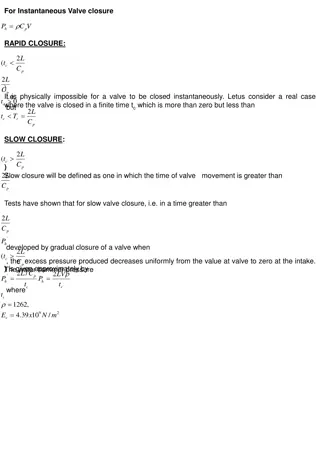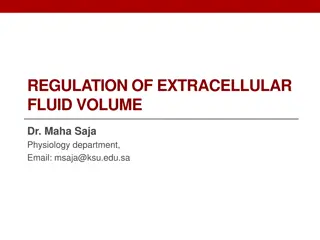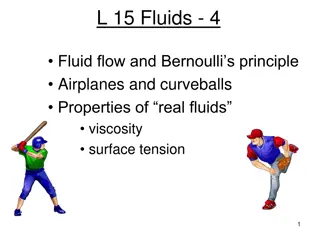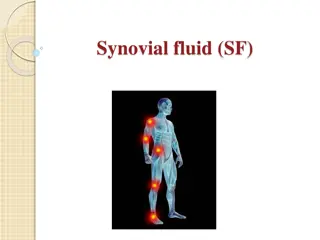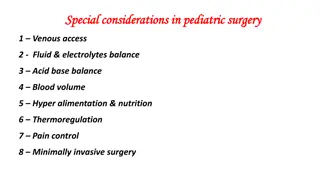Understanding Cerebrospinal Fluid Analysis
Explore the essential aspects of cerebrospinal fluid (CSF) analysis, from routine laboratory assays to interpretation of pathological conditions. Learn about CSF formation, normal parameters, and interpretation of lab results to diagnose various neurological conditions.
Download Presentation

Please find below an Image/Link to download the presentation.
The content on the website is provided AS IS for your information and personal use only. It may not be sold, licensed, or shared on other websites without obtaining consent from the author. Download presentation by click this link. If you encounter any issues during the download, it is possible that the publisher has removed the file from their server.
E N D
Presentation Transcript
Chapter One Cerebrospinal fluid analysis
Addisa Ababa University Jimma University Hawassa University Haramaya University University of Gondar American Society for Clinical Pathology Center for Disease Control and Prevention-Ethiopia
Introduction to Cerebrospinal fluid Routine laboratory assays Collection of sample Gross appearance Cell counts Chemical analysis Morphological Examination Microbiological Examination Serological Examination
Upon completion of this chapter the student will be able to: 1.Describe the formation of CSF from blood. 2. Describe the appearance of normal CSF. 3. Define xanthochromia and state its significance. 4. Differentiate between CSF specimens caused by intracranial hemorrhage and a traumatic tap. 5 Differentiate between CSF specimens caused by intracranial hemorrhage and a traumatic tap.
8. Given the laboratory observations of a bloody CSF, evaluate the supernatant and propose the type of pathological condition associated with a clear supernatant versus a xanthochromic supernatant. 9. Compare the difference of pathological conditions associated with the types of cells observed in a CSF. 10. List the normal range of glucose, protein, and cell count for a CSF. 11. Evaluate abnormal laboratory results with a pathological condition related to CSF. 12. Discuss appropriate collection requirements for CSF following a lumbar puncture.
First recognized by Cotugno in 1764, cerebrospinal fluid (CSF) is a major fluid of the body. CSF provides a physiologic system to supply nutrients to the nervous tissue, remove metabolic wastes, and produce a mechanical barrier to cushion the brain and spinal cord against trauma. CSF is produced in the choroid plexuses of the two lumbar ventricles and the third and fourth venticles. In adults, approximately 20 mL of fluid is produced every hour.
The fluid flows through the subarachnoid space located between the arachnoid and pia mater. To maintain a volume of 90 to 150 mL in adults and 10 to 60 mL in neonates. the circulating fluid is reabsorbed back into the blood capillaries in the arachnoid granulations/villae at a rate equal to its production
Fluid in the space called sub-arachnoid space between the arachnoid mater and pia mater Protects the underlying tissues of the central nervous system (CNS) Serve as mechanical buffer to prevent trauma, regulate the volume of intracranial pressure circulate nutrients remove metabolic waste products from the CNS Act as lubricant Has composition similar to plasma except that it has less protein, less glucose and more chloride ion
Collection of CSF sample Routine Laboratory assays of CSF Gross appearance RBC &WBC counts Morphological Examination Microbiological Examination Serological Examination
Maximum volume of CSF Adults Neonates Rate of formation in adult is 450-750 mL per day or 20 ml per hour reabsorbed at the same rate to maintain constant volume Collection by lumbar puncture done by experienced medical personnel About 1-2ml of CSF is collected for examination lumbar puncture is made from the space between the 4thand 5thlumbar vertebrae under sterile conditions. 150 mL 60 mL
Collected in three sequentially labeled tubes Tube 1 Chemical and immunologic tests Tube 2 Microbiology Tube 3 Hematology (gross examination, total WBC & Diff) This is the list likely to contain cells introduced by the puncture procedure Location of CSF
As soon as the c.s.f. reaches the laboratory, note its appearance. Report whether the fluid: is clear, slightly turbid, cloudy or definitely purulent (looking like pus), contains blood, contains clots. Normal c.s.f. Appears clear and colourless.
Purulent or cloudy c.s.f. Indicates presence of pus cells, suggestive of acute pyogenic bacterial meningitis. Blood in c.s.f. This may be due to a traumatic (bloody) lumbar puncture or less commonly to haemorrhage in the central nervous system. When due to a traumatic lumbar puncture, sample No. 1 will usually contain more blood than sample No. 2.
Following a subarachnoid haemorrhage, the fluid may appear xanthrochromic, i.e. yellow-red (seen after centrifuging). Clots in c.s.f. Indicates a high protein concentration with increased fibrinogen, as can occur with pyogenic meningitis or when there is spinal constriction.
Diagnosis of meningitis of bacterial, fungal, mycobacterial and amoebic origin or differential diagnosis of other infectious diseases subarachnoid hemorrhage or intracerebral hemorrhage
CSF specimen examined visually and microscopically and total number of cells can be counted and identified Specimen: the third tube in the sequentially collected tubes must be counted within 1 hour of collection (cells disintegrate rapidly). If delay is unavoidable store 2- 8oC. All specimens should be handled as biologically hazardous
Glucose is major energy substrate for brain as well as a major carbon source for many molecules. Brain uses 20-25% of total oxygen and 15% of cardiac output is directed to CNS.
When body glucose supply is decreased, other organs decrease glucose utilization to maintain adequate supply of glucose to brain. Other organs can readily switch to oxidation of another substrate for energy production. Under certain conditions, such as chronic starvation, the brain can oxidize other substances but maintains a minimal obligatory requirement for glucose.
Glycolysis--conversion to lactic acid Hexokinase has high activity in brain Serves to trap glucose and maintain concentration gradient for diffusion
2-deoxyglucose is also taken up by brain and phosphorylated by hexokinase, but then becomes trapped Marker to correlate changes in neural activity with changes in glucose utilization. Enolase, an enzyme in glycolytic pathway, exists in nerve cells in unique isoform (neuron specific enolase, NSE) Used as a specific marker for neurons.
Pentose shunt Provides source of D-ribose for synthesis of DNA and RNA Produces NADPH required for lipid syntheses Most active during development
Concept: Amino acids serve many functions in CNS Peptide and Protein synthesis Precursors for transmitters Neurotransmitters
Concept: Neurons must produce those proteins essential for their special functions: conduction of action potentials synaptic transmission axoplasmic transport establishment of specific connections
Structual-cytoskeletal Cell Surface proteins play a role during development in directing neural connections Contractile proteins function in axoplasmic movement Neurotubular protein Glial proteins (glial fibrillary protein)
Enzymes for transmitter synthesis and degradation Transmitter receptors Membrane transporters Ion Channels Growth Factors Synaptic Vesicle
Morphologically identical to neutrophils and bands in blood Occasionally granulation disappears and pseudo-hypersegmentation is observed.
Almost identical morphology to lymphocytes in the blood Due to "flattening-out" of the lymphs during cytocentrifugation, nucleoli may be visible. Found in all fluid
Leukophages:Macrophagescontaining phagocytized WBC. WBCs are often pyknotic and easily confused with NRBC's. Found in all fluids. Erythrophages: Macrophages containing phagocytized RBC or RBC fragments. May contain several RBC. Found in all fluids. Siderophages: Macrophages containing phagocytized particles of hemosiderin, which stain a blue-black color.
These are bright-yellow diamond-shaped crystals of hemosiderin intracellular or extracellular on the slide. They are iron-negative on the Prussian blue stain and therefore Can be noted on the patient report without performing an iron stain.
Metamyelocytes, myelocytes, and promyelocytes may be found in fluids, though they are rarely seen. They are morphologically identical to those in the blood May be due to bone marrow contamination in CSF
Morphologically similar to blasts found in the blood There may be some clover-leaf shaped nuclei due to cytocentrifugal distortion. May be found in all fluids Seen in association lymphomas Bone marrow contamination of CSF with leukemias,
NRBC are rarely seen body fluids. If observed, they should be reported as the number of NRBC per number of WBC counted They must be differentiated from pyknotic WBCs NRBC s are commonly due to peripheral blood or bone marrow contamination of CSF
Plasmacytoid lymphs: Identical in morphology to plasmacytoid lymphs in blood Found in all fluids. Mott cells: Plasma cells with numerous clear cytoplasmic vacuoles containing immunoglobulins
These are most common in CSF from small children with subarachnoid hemorrhage but may be found in all body fluids May be very difficult to distinguish morphologically from large atypical lymphocytes
Malignant cells may be shed from solid tissue (non-hematopoietic) neoplasms into CSF or body cavity fluid submitted for cell counts Fluid will be turbid or bloody Malignant cells are usually seen in clusters of 3- 5 or more, but may occur singly
Intracellular bacteria or yeast can be observed in acute bacterial or fungal infections It is important to coordinate your findings with those of the Microbiology Section of the laboratory
When the CSF is pinkish red, this usually indicates the presence of blood, which may have resulted from: Sub arachnoid hemorrhage Intra cerebral hemorrhage Infarct traumatic tap
1st - Chemistry 2nd - Microbiology 3rd - Hematology
Color Xanthochromia Hyperbilirubinemia Increased Protein Turbidity Increased White Blood Cells (Pleocytosis)
A traumatic tap shows progressively decreasing RBC in serial samples Generally, in subarachnoid hemorrhage, the RBC would be consistent from one tube to the next
After the CSF is centrifuged, the supernatant fluid is clear in a traumatic tap, but it is xanthochromic in a subarachnoid hemorrhage Xanthochromia of the CSF refers to a pink, orange, or yellow color of the supernatant after the CSF has been centrifuged
The white cell count is increased when there is inflammation of the central nervous system, particularly the meninges Bacterial infections are usually associated with the presence of neutrophils in the CSF
Viral infections are associated with an increase in mononuclear cells An increase in mononuclear cells may also be seen with: cerebral abscess acute leukemia Lymphoma intracranial vein thrombosis cerebral tumor multiple sclerosis
A white cell count with an indication whether the cells are pus cells or lymphocytes, is required when the c.s.f. appears slightly cloudy or clear or when the Gram smear does not indicate pyogenic bacterial meningitis
Method To identify whether white cells in the c.s.f. are polymorphonuclear neutrophils (pus cells) or lymphocytes, dilute the c.s.f. in a fluid which stains the cells. Istonic 0.1% toluidine blue is recommended because it stains lymphocytes and the nuclei of pus cells blue. C. neoformans yeast cells stain pink. Red cells remain unstained. The motility of trypanosomes is not affected by the dye. When toluidine blue is unavailable, isotonic methylene blue can be used which will also stain the nuclei of leucocytes.






